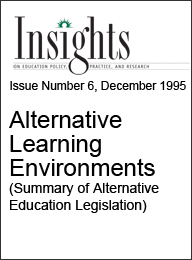Implications of Mandates
Alternative education clearly leads to success under certain conditions. Arkansas, Texas, and other states throughout the nation have acted on this finding by passing legislation requiring school districts to provide an alternative educational setting for students. The goals underlying these state mandates - to prevent dropping out and provide an educational environment for expelled and suspended students - are laudable. However, the effects of the mandates remain unclear. Mandating alternative learning environments changes both the district's motivation for establishing such schools and the methods by which students enroll in them. These changes have important implications that policymakers should consider as they revise existing law and draft new legislative proposals.
One of the most important consequences resulting from mandate is that it severely restricts choice in alternative education. Restricting choice creates uncertainty regarding expected outcomes, because most, if not all, of the current research examines programs established and attended by choice. If students choose to attend a program and must apply to enroll, they do not represent the entire population of students at-risk of educational failure, but rather reflect those who have some motivation (either internal or external) to stay in school. The results of existing research, therefore, cannot be generalized to mandated programs that must work for all students at-risk - including those youth assigned and required to attend. Thus, the effectiveness of such programs is unknown.
Two important facts suggest that requiring participation in programs may affect their results. First, as seen in Table 1, most alternative school proponents cite choice as crucial for success. In most successful programs, everyone involved with the school, from the administrators to the students, works in or attends the school by choice. Choice facilitates feelings of ownership and commitment to the school. Therefore, reducing or eliminating choice, by requiring districts to establish schools and requiring students to attend, may lower the overall success rate.
Second, if student motivation correlates with applying to attend school, then the student population at "required" alternatives will include a less motivated, and perhaps more at-risk, population. This difference in population may depress the overall success rate, because students with multiple or severe risk factors have higher drop out rates even at alternative schools (Hahn & Danzberger, with Lefkowitz, 1987).
Thus, eliminating choice may jeopardize the culture of the alternative education program by changing the impetus for its existence as well as the population of students attending. States that mandate programs will need to carefully evaluate them to determine their success, taking student population differences into account. It is important to note, however, that although the inclusion of higher-need students may lower the overall success rate, the program may still be successful with lower-need students. Therefore, results should be evaluated not only for the entire program, but also for different groups of students.
In addition to the choice factor, policymakers must consider funding issues when mandating programs. If states provide additional funds for alternative education programs, it is possible that districts will identify more students "at-risk" and place them in alternative programs in order to receive additional funds. However, if states do not provide sufficient funds, mandates may negatively affect both alternative programs and traditional schools. Without additional state funds, many districts will have to divert money from traditional school programs to meet the requirements of the mandate, and some will still have insufficient resources to create effective alternative programs. Policymakers, therefore, need to weigh the risk of districts over-identifying students for alternative education against the risk of underfunding programs for students who need them.
Next Page: Mandates: Policy Considerations

